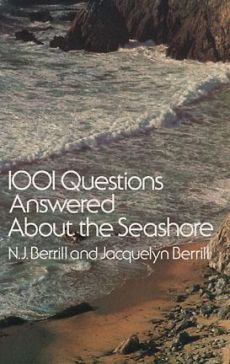1001 Questions Answered
About the Seashore
by N.J. Berrill and Jacquelyn Berrill
With literally hundreds of miles of seashore Long Island Beaches present a magnificent opportunity for beachcombing and collecting seashells.

Unlike popular tourist beaches in other parts of the world which are constantly picked clean, a walk along one of Long Island’s beaches can yield an amazing quantity and variety of seashells and other “things” from the ocean.
And, if you’re curious about what exactly you’ve come home with after a day of beachcombing, then 1001 Questions Answered About the Seashore is the book for you.
This is not a new book to me and has actually been kicking around my home library for years. I’m not sure, but I think I picked it up at the ranger station at Sailor’s Haven one summer.
Every summer it somehow finds its way from the bookshelf onto my coffee table. It stays there at the ready until sometime in late fall when summer is swept away by the brisk autumn winds and my trips to the beach are far less frequent. Then, seemingly all by itself, it makes its way back to the shelf.
1001 Questions Answered About the Seashore is a Dover reprint of the original which was first published in 1957. 1957 may sound like a long time ago, but since life evolves on a very slow time scale, the information is still valid.
If you’ve read my other book reviews, you’ll know that I’m fond of pick-it-up-and-start-anywhere kind of books. This is one of them.
The book is very simply organized in Q & A format. Starting from question #1 and ending at #1105 1001 Questions Answered About the Seashore is a non-stop adventure at the beach and ocean.
Some of the questions have startling answers:
The shells of the boring clams, capable of penetrating coral, moderately hard rocks, and wood, are white, thin and brittle generally elongated, and narrowed toward the posterior end, with a sharp, abrading structure on the anterior end.
The borers include the wing shells, the angel’s wing and above all, the piddock drills into rocks so hard that nothing short of a sledge hammer powerfully swung will break into the burrows, and it apparently drills without the aid of chemicals using mechanical means only.
The animal twists and rocks itself on its round muscles foot (which takes the form of a suction disk that grips the rock), pressing its rough valve outward at the same time so as to bring them into contact with the walls of the burrow.
Such a method of drilling is necessarily slow in ratio to the hardness of the rock, partly because the continual wearing of the shell must be compensated by growth.
A clam that drills holes in solid rock? I am simply amazed by that.
And some of the answers are profound:
In the first place, if you already have this book in your hand you are probably on or near a seashore, or have prospects of going to one. So why waste such an opportunity?
If you are on vacation you may even now be a little bit bored with sitting around getting a sun tan and a variety of beach views. In any case the nonhuman life of the shore and the shallow sea beyond it is fantastic, of truly great interest and of almost unbelievable antiquity.
It is time you became acquainted, for here, right on the shore at your feet, is as wild a jungle in its own way as any tropical forest and of a kind that well may outlast mankind itself.
But the creatures which inhabit it either hide from view or are so still that you accept them as part of the maritime landscape. They are worth getting to know, for their way of life is as successful as yours and has been tested for a much longer time.
Every living thing between high tide and low is a colonist who meets his sea of troubles day by day in a quiet but effective manner. Those that you can find will surprise you with both their numbers and their variety. Some of them will be beautiful, some bizarre, but each one fascinating in its own peculiar way.
Every time I read the answer to question #1 I want to go to the beach.
1001 Questions Answered About the Seashore is not specifically about Long Island beaches, but the book covers the topic so well that every Long Island beach lover should have a copy.
The book is illustrated with ink drawings and black and white pictures.
Although the illustrations and photos are adequate, I do wish the book had more of them.
1001 Questions Answered About the Seashore
N.J. Berrill and Jacquelyn Berrill
Dover Publications, 1976
305 pages
5¼ x 8¼
Back to Best Long Island Books





New! Comments
Have your say about what you just read! Leave me a comment in the box below.